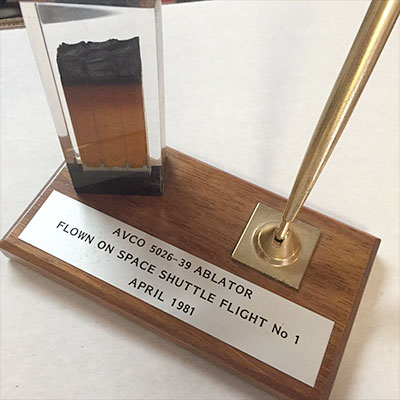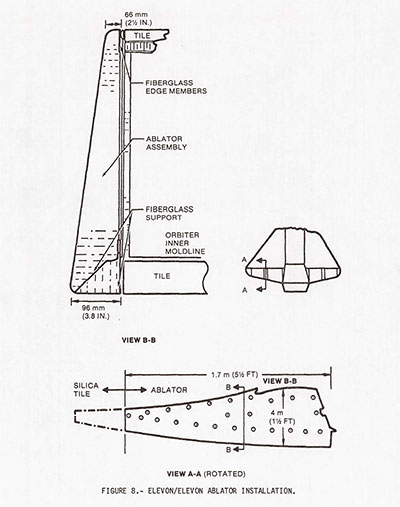|
|

|
|
Author
|
Topic: 121880428499: AVCO ablator from STS-1
|
Robert Pearlman
Editor Posts: 42988
From: Houston, TX
Registered: Nov 1999
|
 posted 02-06-2016 02:06 PM
posted 02-06-2016 02:06 PM
   
I had been watching this now closed eBay auction: AVCO 5026-39 ABLATOR (Heat Shield) Desk Model. It sold today for $356.79.What intrigued me about this desk set with an acrylic-encased sample of Avcoat heat shield was what was written on the plaque: AVCO 5026-39 Ablator
Flown on Space Shuttle Flight No. 1
April 1981 I was in touch with the seller because to my knowledge (and the best of my searches), such an ablator was not part of the space shuttle's thermal protection system. I asked if perhaps the desk set had been repaired or if the plaque had been added in the time since it was presented, but he said that to his knowledge, it was exactly how his father received it 35 years ago. I checked the STS-1 Official Flight Kit manifest to see if perhaps a commemorative sample had been flown, but there was no such listing. I suppose it could have been part of Young's or Crippen's PPKs (Young would make some sense, I guess, given his Apollo history), but there is no indication of that, if that was the case. I did not bid on the auction, but can anyone shed light on how an Avcoat ablator sample ended up on Columbia — if indeed it did?  |
CMikeW
Member Posts: 89
From: United States
Registered: Apr 2013
|
 posted 02-06-2016 06:08 PM
posted 02-06-2016 06:08 PM
  
Here's what I got from Wikipeadia this evening. AVCOAT was used for the heat shield on NASA's Apollo Command Module. In its final form, this material was called AVCOAT 5026-39.Although AVCOAT was not used for the Space Shuttle orbiters, NASA is using the material for its next generation Orion spacecraft.[6] The Avcoat to be used on Orion is reformulated to meet environmental legislation that has been passed since the end of Apollo. The ablator was not flown on the outside of the shuttle. It might have been a stowage item, but I kind of doubt it. I can't see any significant linkage between the artifact and the space shuttle. It does look to me to be a cross section of an ablator type heat shield after a re-entry. The Wiki article had this added info about using Avcoat on Orion. The biggest challenge with Avcoat has been reviving the technology to manufacture the material such that its performance is similar to what was demonstrated during the Apollo missions," said John Kowal, Orion's thermal protection system manager at Johnson. "Once that had been accomplished, the system evaluations clearly indicated that Avcoat was the preferred system. Since AVCO was bought by Textron in the early 1980s, I'm guessing the there wasn't anybody around who cared about flying an old piece of used ablator on a space shuttle mission. Especially if the company who made it originally was really no longer in business.By the way, the desk set sure looks to be in fantastic condition after being around for 35 years. |
Robert Pearlman
Editor Posts: 42988
From: Houston, TX
Registered: Nov 1999
|
 posted 02-06-2016 07:40 PM
posted 02-06-2016 07:40 PM
   
Wikipedia's entry summarizes my existing understanding of the situation, though that site can only be used as a starting point for research given the way it is edited. As for the desk set, I have a number of mementos from STS-1 that are in similar condition, so that, in-of-itself, is not necessarily unusual. |
Jeff
Member Posts: 474
From: Fayetteville, NC, USA
Registered: May 2009
|
 posted 02-07-2016 09:04 AM
posted 02-07-2016 09:04 AM
   
Robert, I'm sure you've seen this but if not this is a Skinner auction where it looks like a piece similar was sold in 2006. |
Robert Pearlman
Editor Posts: 42988
From: Houston, TX
Registered: Nov 1999
|
 posted 02-07-2016 09:56 AM
posted 02-07-2016 09:56 AM
   
Jeff, interesting! I had not seen that before (or if I had, I had forgotten about it). From the Skinner auction: Tile From the Apollo Command Module, enclosed in a Perspex cell, mounted on a similar but unused tile, with brass plaques engraved "Allen A. Navarro" and "Avco 5026-39 Ablator Flown on Space Shuttle Flight No. 1, April 1981"...Developed by AVCO, the tiles were abandoned after the first few flights because the material could not be re-used after the landing. Only three commemorative tiles were reportedly produced, one for the President, one for the chief engineer, and the third for Allen Navarro, the chief contract negotiator between AVCO and NASA. So, were there Avcoat tiles on Columbia, even as an experiment? At the least, the Skinner auction now makes the eBay auction harder to dismiss as a one-off mistake. |
Robert Pearlman
Editor Posts: 42988
From: Houston, TX
Registered: Nov 1999
|
 posted 02-07-2016 10:20 AM
posted 02-07-2016 10:20 AM
   
So, as it turns out, NASA's list of space shuttle subcontractors credits Avco of Lowell, Massachusetts for providing the elevon ablator. The second volume of T.A. Heppenheimer's "History of the Space Shuttle" explains: Late in development, thermal analysis and wind tunnel testing indicated that the areas between the elevons, midway along the span, would reach 3,200 degrees Fahrenheit — far too high for any RSI, even LI-2200. NASA responded by turning to its old standby, the ablative of the Apollo heat shield. Small panels of this ablator, placed at the facing edges of the elevon segments, solved the problem, even though the panels had to be replaced after every flight. |
pupnik
Member Posts: 114
From: Maryland
Registered: Jan 2014
|
 posted 02-07-2016 10:45 AM
posted 02-07-2016 10:45 AM
  
There's a report the describes it a little on NTRS. Starting on the bottom of page 1066 (page 503 of the pdf). |
Robert Pearlman
Editor Posts: 42988
From: Houston, TX
Registered: Nov 1999
|
 posted 02-07-2016 11:29 AM
posted 02-07-2016 11:29 AM
   
Thanks! Here's the relevant passage for reference: Before the first flight of Columbia and late in the orbiter fabrication cycle, thermal analysis/wind tunnel testing indicated that the areas between the inboard and outboard elevons would encounter temperatures that were too high for tiles to survive even a single mission (~3200° F). Therefore, an ablative material was installed between the split segments of the elevons (outboard end of each inboard elevon and inboard end of each outboard elevon) as shown in figure 8. The ablative material (AVCOAT 5026-39HC/G) was the same as the Apollo heat shield material. It consisted of an epoxy-novolac resin filled with microballoons and a mixture of silica and E-glass fibers. The resin mixture was injected into a fiberglass, open-faced honeycomb core which was bonded to an aluminum plate. Since the ablator chars and undergoes surface erosion, it was replaced after each flight. As a result, the ablator system was mechanically attached to the wing structure for easy installation and removal. The first five flights indicated lower temperatures than initially predicted. All orbiters are now being returned to the original reusable silica tile design in the elevon split area.  |
Robert Pearlman
Editor Posts: 42988
From: Houston, TX
Registered: Nov 1999
|
 posted 02-07-2016 12:15 PM
posted 02-07-2016 12:15 PM
   
Well, given the above, I think whoever won the eBay auction for $357 got a heck of a deal for an STS-1 flown example of Avcoat... |
CMikeW
Member Posts: 89
From: United States
Registered: Apr 2013
|
 posted 02-07-2016 01:48 PM
posted 02-07-2016 01:48 PM
  
I stand corrected. |
CMikeW
Member Posts: 89
From: United States
Registered: Apr 2013
|
 posted 02-11-2016 03:00 PM
posted 02-11-2016 03:00 PM
  
I talked to a couple other old guys at our monthly "old Guys and Gals" luncheon today and confirmed that STS-1 and a few other early flights on Columbia OV-102 were equipped with Abalator on at least the outboard vertical face of the inboard elevons. There should be more than enough material from the flights, since it looks like it was replaced each flight, to make a desk set for anybody who wants one.The pieces are probably sitting in a warehouse at JSC along with many thousands of other items. As I remember it, early on, just about any thing that was removed from the orbiter after a flight was treated as something special, i.e. flown hardware. Later on I saw plenty just get thrown in the trash because there was just so much stuff to deal with. | |
Contact Us | The Source for Space History & Artifacts
Copyright 2020 collectSPACE.com All rights reserved.

Ultimate Bulletin Board 5.47a
|
|

|
 advertisement advertisement

|













